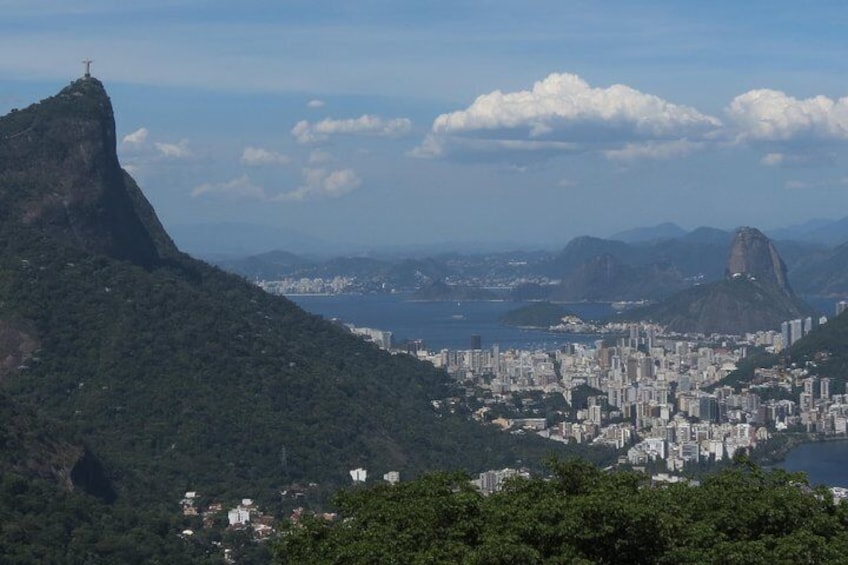




Full-Day Custom Private Tour of Rio
10/10
10 out of 10Features
- Free cancellation available
- 8h
- Mobile voucher
- Instant confirmation
- Selective hotel pickup
- Multiple languages
Overview
8-hour fully customised tour of Rio with a private local guide. Have private transport at your disposal to take you to all the sites you want to see in Rio. Great for experienced travellers who want to make the most of their visit. Whether you're looking to go to the main attractions, or the places that aren't so touristy, your private guide will be there to recommend the best spots and ways to beat the crowds. Tour is limited to a maximum of four people and includes pickup and drop-off from your accommodation in Rio, or the cruise port or airport.
Activity location
- Luis Darin Private Tour Guide In Rio
- 22060-002, Rio de Janeiro, State of Rio de Janeiro, Brazil
Meeting/Redemption Point
- Luis Darin Private Tour Guide In Rio
- 22060-002, Rio de Janeiro, State of Rio de Janeiro, Brazil
Check availability
ENGLISH, SPANISH & PORTUGUESE in Multilingual
- 8h
- Opening hours: Sat 7:00 am-11:00 am
- English
Larger Vehicles: 1 person - Compact Car
2 to 3 people -Saloon
4 to 5 people - SUV
6 to 10 people – Van
English, Spanish & Portuguese: This tour version can be conducted in English, Spanish or Portuguese upon your convenience.
Pickup included
What's included, what's not
- Local guide
- Tolls and parking fees
- Landing and facility fees
- Fuel surcharge
- Transport in a private car
- Customer’s admission tickets for the attractions visited on the tour
- Meals or drinks (if any)
Know before you book
- Specialised infant seats are available
- Wheelchair accessible
- Infants and small children can ride in a pram or stroller
- Public transport options are available nearby
- Transport options are wheelchair accessible
- Suitable for all physical fitness levels
- Children must be accompanied by an adult
- A maximum of 4 people per booking
- Pricing is per group pricing
- Please advise any specific dietary requirements at time of booking
- Vegetarian option is available, please advise at time of booking if required
- All tours are private and conducted in air conditioned vehicle.
- Your admission tickets for the attractions visited on the tour and any meals or drinks are not included. Admission fees will be paid directly at the attractions.
Activity itinerary
Luis Darin Private Tour Guide In Rio
- 10m
Sugarloaf Mountain (Pass by)
Sitio Roberto Burle Marx (Pass by)
Centro Cultural Municipal Parque das Ruinas (Pass by)
Theatro Municipal do Rio de Janeiro (Pass by)
Botanical Garden (Pass by)
Paco Imperial (Pass by)
Centro Cultural Banco do Brasil - CCBB Rio de Janeiro (Pass by)
Parque Nacional da Tijuca (Pass by)
Copacabana Beach (Pass by)
Ipanema Beach (Pass by)
Sao Bento Monastery (Pass by)
Maracana (Pass by)
Claudio Coutinho Trail (Pass by)
Sambodromo da Marques de Sapucai (Pass by)
Forte Duque de Caxias (Pass by)
Parque Lage (Pass by)
Arpoador beach (Pass by)
Perigoso Beach (Pass by)
Rodrigo de Freitas Lagoon (Pass by)
Avenida Atlantica (Pass by)
Carioca Aqueduct (Pass by)
Macumba Beach (Pass by)
Praca Quinze de Novembro (Pass by)
Aterro Do Flamengo (Pass by)
Marina Da Gloria (Pass by)
Morro da Urca (Pass by)
Arco do Teles (Pass by)
Santa Teresa (Pass by)
Parque da Cidade (Pass by)
Feira de Sao Cristovao (Pass by)
Cosme Velho (Pass by)
Corcovado - Christ the Redeemer (Pass by)
Leme (Pass by)
Escadaria Selaron (Pass by)
Ipanema Farmer's Market (Pass by)
Sao Francisco da Penitencia Church (Pass by)
Mirante Do Leblon (Pass by)
Morro Dois Irmaos (Pass by)
Guanabara Palace (Pass by)
Urca (Pass by)
Barra da Tijuca Beach (Pass by)
Abrico Beach (Pass by)
Praia de Grumari (Pass by)
Praia Da Joatinga (Pass by)
Praia do Leme (Pass by)
Recreio dos Bandeirantes Beach (Pass by)
Vermelha Beach (Pass by)
Palacio Capanema (Pass by)
Vista Chinesa (Pass by)
Boa Viagem Island (Pass by)
Parque Nacional da Serra dos Orgaos (Pass by)
Mirante do Soberbo (Pass by)
Dedo de Deus (Pass by)
Prainha Beach (Pass by)
Ponte Rio–Niteroi (Pass by)
Pedra do Sal (Pass by)
Ilha Da Gigoia (Pass by)
Pontal Beach (Pass by)
Reserva Beach (Pass by)
Beco das Sardinhas (Pass by)
Museum of Valongo Wharf (Pass by)
Centro de Visitantes Von Martius Museum (Pass by)
Cachoeira do Rio dos Frades (Pass by)
Pedra Bonita (Pass by)
Cais do Valongo (Pass by)
Caminho Niemayer (Pass by)
Morro da Babilonia (Pass by)
Mirante do Caete (Pass by)
Mirante do Joa (Pass by)
Pedra do Telegrafo (Pass by)
Praia do Secreto (Pass by)
Mirante do Leme (Pass by)
Parque Natural Municipal da Prainha (Pass by)
Travessa do Comercio (Pass by)
Maua Square (Pass by)
Igreja Nossa Senhora do Carmo da Antiga Se (Pass by)
Statue of General Osorio (Pass by)
Poco Verde (Pass by)
Mestre Valentim Fountain (Pass by)
Pedra do Pontal (Pass by)
Trilha do Pao de Acucar (Pass by)
Largo dos Guimaraes (Pass by)
Rio de Janeiro Historic City Center (Pass by)
Boulevard Olimpico (Pass by)
Painel Etnias (Pass by)
Morro da Conceicao (Pass by)
Pier Maua (Pass by)
AquaRio (Pass by)
Igreja de Sao Francisco da Prainha (Pass by)
Centro de Visitantes Paineiras (Pass by)
Rampa Pedra Bonita (Pass by)
Museu Historico do Exercito e Forte de Copacabana (Pass by)
Praia do Meio (Pass by)
Floresta da Tijuca (Pass by)
Cascatinha Taunay (Pass by)
Museu Selecao Brasileira - CBF (Pass by)
Confeitaria Colombo (Pass by)
Location
Activity location
- Luis Darin Private Tour Guide In Rio
- 22060-002, Rio de Janeiro, State of Rio de Janeiro, Brazil
Meeting/Redemption Point
- Luis Darin Private Tour Guide In Rio
- 22060-002, Rio de Janeiro, State of Rio de Janeiro, Brazil